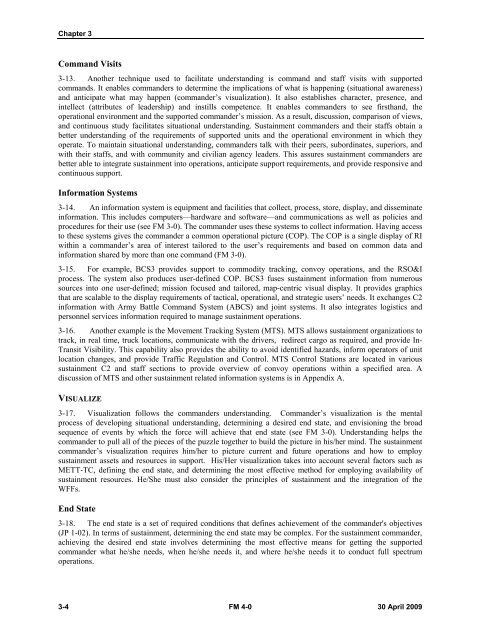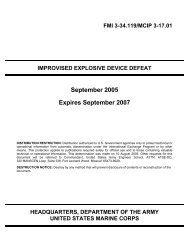FM 4-0, Sustainment - GlobalSecurity.org
FM 4-0, Sustainment - GlobalSecurity.org
FM 4-0, Sustainment - GlobalSecurity.org
- No tags were found...
Create successful ePaper yourself
Turn your PDF publications into a flip-book with our unique Google optimized e-Paper software.
Chapter 3Command Visits3-13. Another technique used to facilitate understanding is command and staff visits with supportedcommands. It enables commanders to determine the implications of what is happening (situational awareness)and anticipate what may happen (commander’s visualization). It also establishes character, presence, andintellect (attributes of leadership) and instills competence. It enables commanders to see firsthand, theoperational environment and the supported commander’s mission. As a result, discussion, comparison of views,and continuous study facilitates situational understanding. <strong>Sustainment</strong> commanders and their staffs obtain abetter understanding of the requirements of supported units and the operational environment in which theyoperate. To maintain situational understanding, commanders talk with their peers, subordinates, superiors, andwith their staffs, and with community and civilian agency leaders. This assures sustainment commanders arebetter able to integrate sustainment into operations, anticipate support requirements, and provide responsive andcontinuous support.Information Systems3-14. An information system is equipment and facilities that collect, process, store, display, and disseminateinformation. This includes computers—hardware and software—and communications as well as policies andprocedures for their use (see <strong>FM</strong> 3-0). The commander uses these systems to collect information. Having accessto these systems gives the commander a common operational picture (COP). The COP is a single display of RIwithin a commander’s area of interest tailored to the user’s requirements and based on common data andinformation shared by more than one command (<strong>FM</strong> 3-0).3-15. For example, BCS3 provides support to commodity tracking, convoy operations, and the RSO&Iprocess. The system also produces user-defined COP. BCS3 fuses sustainment information from numeroussources into one user-defined; mission focused and tailored, map-centric visual display. It provides graphicsthat are scalable to the display requirements of tactical, operational, and strategic users’ needs. It exchanges C2information with Army Battle Command System (ABCS) and joint systems. It also integrates logistics andpersonnel services information required to manage sustainment operations.3-16. Another example is the Movement Tracking System (MTS). MTS allows sustainment <strong>org</strong>anizations totrack, in real time, truck locations, communicate with the drivers, redirect cargo as required, and provide In-Transit Visibility. This capability also provides the ability to avoid identified hazards, inform operators of unitlocation changes, and provide Traffic Regulation and Control. MTS Control Stations are located in varioussustainment C2 and staff sections to provide overview of convoy operations within a specified area. Adiscussion of MTS and other sustainment related information systems is in Appendix A.VISUALIZE3-17. Visualization follows the commanders understanding. Commander’s visualization is the mentalprocess of developing situational understanding, determining a desired end state, and envisioning the broadsequence of events by which the force will achieve that end state (see <strong>FM</strong> 3-0). Understanding helps thecommander to pull all of the pieces of the puzzle together to build the picture in his/her mind. The sustainmentcommander’s visualization requires him/her to picture current and future operations and how to employsustainment assets and resources in support. His/Her visualization takes into account several factors such asMETT-TC, defining the end state, and determining the most effective method for employing availability ofsustainment resources. He/She must also consider the principles of sustainment and the integration of theWFFs.End State3-18. The end state is a set of required conditions that defines achievement of the commander's objectives(JP 1-02). In terms of sustainment, determining the end state may be complex. For the sustainment commander,achieving the desired end state involves determining the most effective means for getting the supportedcommander what he/she needs, when he/she needs it, and where he/she needs it to conduct full spectrumoperations.3-4 <strong>FM</strong> 4-0 30 April 2009

















